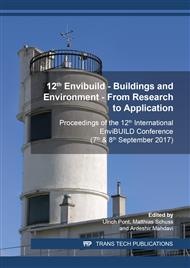[1]
Víctor Manuel Soto Francés, Emilio José Sarabia Escriva, José Manuel Pinazo Ojer, Emilie Bannier, Vicente Cantavella Soler, Gonzalo Silva Moreno, Modeling of ventilated façades for energy building simulation software, Energy and Buildings, Volume 65, October 2013, Pages 419-428.
DOI: 10.1016/j.enbuild.2013.06.015
Google Scholar
[2]
Giuseppe Oliveti, Natale Arcuri, Marilena De Simone, Roberto Bruno, Experimental evaluations of the building shell radiant exchange in clear sky conditions, Solar Energy, Volume 86, Issue 6, June 2012, Pages 1785-1795.
DOI: 10.1016/j.solener.2012.03.009
Google Scholar
[3]
Mottard, Jean-Michel, Fissore, Adelqui, 2007. Thermal Simulation of an attached sunspace and its experimental validation. Solar Energy, Volume 81, Pages 305–315.
DOI: 10.1016/j.solener.2006.07.005
Google Scholar
[4]
Roux, J.J., Teodosiu, C., Covalet, D., Chareille, R., 2004. Validation of a glazed space simulation model using full-scale experimental data. Energy and Buildings 36, 557–565.
DOI: 10.1016/j.enbuild.2004.01.030
Google Scholar
[5]
L. Adelard, F. Pignolet-Tardan, T. Mara, P. Lauret, F. Garde, H. Boyer, Sky temperature modelisation and applications in building simulation, Renewable Energy, Volume 15, Issues 1–4, September–December 1998, Pages 418-430.
DOI: 10.1016/s0960-1481(98)00198-0
Google Scholar
[6]
M. Čekon, Accuracy analysis of longwave sky radiation models in the MZELWE module of the ESP-r program, Energy and Buildings, Volume 103, 15 September 2015, Pages 147-158.
DOI: 10.1016/j.enbuild.2015.06.039
Google Scholar
[7]
Štaffenová, D., Ponechal, R., Ďurica, P., Cangár, M. Climate data processing for needs of energy analysis Advanced Materials Research, 2014, Vol. 1041, pp.129-134.
DOI: 10.4028/www.scientific.net/amr.1041.129
Google Scholar
[8]
Berger X, Cubizolles B, Donet I. Radio-sounding data for the determination of the infra-red sky radiation. Int. J. Solar Wind Technology 1988, Volume 5(4), Pages 353–363.
DOI: 10.1016/0741-983x(88)90002-1
Google Scholar
[9]
Berger X, Bathiebo J. From spectral clear sky emissivity to total clear sky emissivity. Int. J. Solar Wind Technology 1989, Volume 6(5), Pages 551-556.
DOI: 10.1016/0741-983x(89)90090-8
Google Scholar
[10]
Berger X, Bathiebo J, Kieno F, Awanou CN. Clear sky radiation as a function of altitude. Int. J. Renewable Energy 1992, Volume 2(2), Pages 139-157.
DOI: 10.1016/0960-1481(92)90100-h
Google Scholar
[11]
Berger X, Awanou CN, Bathiebo J. Expressions for computing the radiative cooling flux from the sky in different climates. Int. J. Ambient Energy, 1988, Vol. 9, Pages 155-164.
DOI: 10.1080/01430750.1988.9675928
Google Scholar
[12]
M. Pérez-Garcı́a, Simplified modelling of the nocturnal clear sky atmospheric radiation for environmental applications, Ecological Modelling, Volume 180, Issues 2–3, 2004, Pages 395-406.
DOI: 10.1016/j.ecolmodel.2004.04.027
Google Scholar
[13]
W. C. Swinbank, Long-wave radiation from clear skies. Quarterly Journal of the Royal Meteorological Society, 1963, Pages 339-348.
DOI: 10.1002/qj.49708938105
Google Scholar
[14]
Runsheng Tang, Y. Etzion, I.A. Meir, Estimates of clear night sky emissivity in the Negev Highlands, Israel, Energy Conversion and Management, Volume 45, Issues 11–12, July 2004, Pages 1831-1843.
DOI: 10.1016/j.enconman.2003.09.033
Google Scholar
[15]
J. A. Clarke, Energy simulation in building design. Butterworth-Heinemann. Oxford, 2nd edition 2001. 362 p. ISBN 0 7506 5082 6.
Google Scholar
[16]
J. I. Jiménez, L. Alados-Arboledas, Y. Castro-Díez, G. Ballester, On the estimation of long-wave radiation flux from clear skies, Theoretical and Applied Climatology, 1987, Volume 38, Issue 1, Pages 37-42.
DOI: 10.1007/bf00866251
Google Scholar
[17]
M. Martin, P. Berdahl, Characteristics of infrared sky radiation in the United States. Solar Energy, 1984, Volume 33, Pages 321-336.
DOI: 10.1016/0038-092x(84)90162-2
Google Scholar
[18]
Information on http://www.kippzonen.com/Product/17/CGR4-Pyrgeometer.
Google Scholar
[19]
M. Čekon, R. Slávik, P. Juráš, Obtainable Method of Measuring the Solar Radiant Flux Based on Silicone Photodiode Element,, Applied Mechanics and Materials, Vol. 824, pp.477-484, (2016).
DOI: 10.4028/www.scientific.net/amm.824.477
Google Scholar


